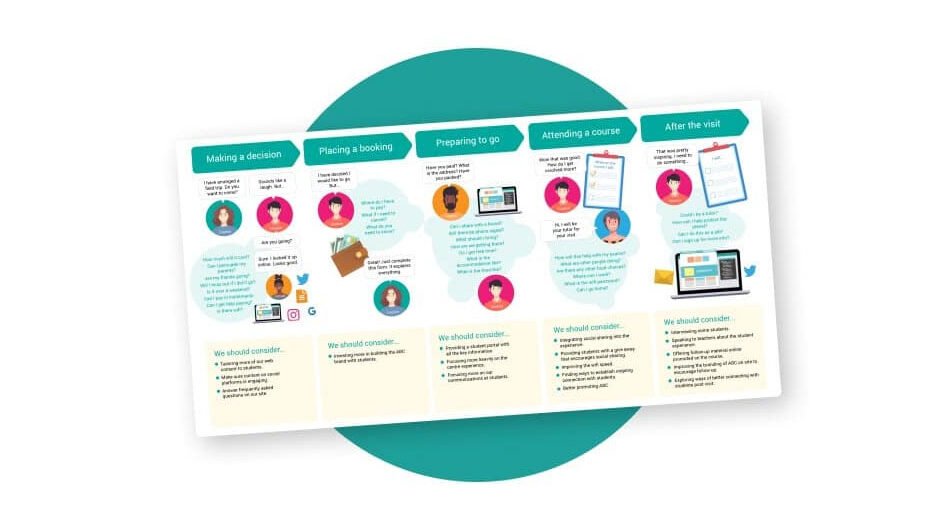Customer journey maps narrate the story of how customers interact with your brand across various touchpoints. These maps are powerful tools that help businesses decode consumer behavior, leading to the enhancement and optimization of user experiences. While some “experts” may complicate this process, others adopt a straightforward and logical approach to creating customer journey maps, eliminating unnecessary complexities and focusing on what truly matters.
How to create a customer journey map from scratch
A well-crafted customer journey mapping enables businesses to visualize every step and experience a customer encounters with their brand. By framing this experience as a story, companies can better understand the needs and desires of their customers at each stage of their journey. This visualization provides a comprehensive overview of potential interactions, allowing for strategic adjustments that can significantly enhance the customer experience.
1. Set goals
Establish clear goals to measure the impact of your customer journey map on both customers and your business. Identify current and future buyers to set specific goals for each stage of their experience. Engage cross-functional teams to gather diverse perspectives on improving the customer journey and defining measurable improvements.
Pro Tip: Develop buyer personas if not already in place to focus your customer journey map on targeted buyer types.
2. Conduct persona research
Gather comprehensive data about the personas driving your customer journey map. Depending on your business maturity, compile existing data or engage directly with real customers through interviews, surveys, and analytics. Collect both qualitative insights and quantitative metrics like Net Promoter Score (NPS) to inform data-driven decisions.
3. Define customer touchpoints
Customer touchpoints are crucial interactions where customers engage with your brand. Tailor your customer journey map by identifying touchpoints that reflect your unique business context, whether you’re a SaaS company or a local coffee shop. Include insights into actions, emotions, and potential challenges at each touchpoint.
4. Map the current state
Visualize the current customer journey using tools. Organize touchpoints and data collaboratively with stakeholders to accurately depict the customer experience. Prioritize content over aesthetics, detailing actions, channels, and ownership responsibilities (e.g., sales, customer service). Use design elements to enhance clarity and highlight key aspects of the journey.
5. Map future states
Identify gaps and pain points in the current customer journey map. Use tools to propose solutions and visualize an improved future state. Share findings across your organization to align on necessary improvements and roles in enhancing the customer journey. Present a roadmap for implementing changes and achieving desired outcomes.
Understanding customer journey management
Customer journey management improves your organization’s ability to deliver value by understanding and efficiently meeting customer goals. It ensures each interaction aligns with the customer’s unique journey context. Satisfied customers, in turn, contribute value to your business, making it crucial to identify key experiences and measure their impact on outcomes.
However, many enterprises struggle to link customer behavior directly to business outcomes. Nearly 41% of companies track improvements in metrics like NPS or customer satisfaction but find it challenging to translate these into revenue or cost reductions.
A journey management program benefits your enterprise by:
- Optimizing customer experience: It allows you to provide consistent, exceptional experiences across all channels. By monitoring and optimizing journeys, you can pinpoint areas for improvement and prioritize actions based on their impact on CX KPIs.
- Accelerating digital transformation: Journey management helps companies meet evolving customer expectations by simplifying digital experiences and reducing the need for human interaction.
- Improving customer service while reducing costs: By understanding why customers seek agent assistance, you can support them more effectively, reducing call center metrics like call time and repeat calls.
- Growing revenue: Customer journey management enables marketing teams to deliver differentiated experiences, track acquisition journeys, and increase retention by addressing the root causes of churn.
Best practices for customer journey management
1. Set clear goals
Before starting customer journey mapping, define what you want to achieve. Clear objectives ensure alignment with both customer and business goals. Jamie Irwin, Director & Search Marketing Expert at Straight Up Search, stresses the importance of knowing your goals and KPIs before mapping. This clarity helps you design a map that meets your objectives, such as understanding user needs or optimizing conversions.
2. Understand your customers
Research is key to understanding different buyer personas. Interview diverse users to create detailed personas and avoid overgeneralization. Use tools to gather feedback and insights directly from users to improve their journey.
3. Create different maps for each buyer type
Design unique maps for each persona, as different buyers have varied behaviors and preferences. Use tools to tailor your website’s content to suit different user needs.
4. Collaborate with stakeholders
Involve stakeholders across your organization to ensure a unified approach to creating a customer journey map. Engage teams with customer insights and high-level decision-makers to secure buy-in and smooth implementation.
5. Track every step
Be thorough in tracking every phase of the customer journey, from initial contact to post-purchase. Map specific touchpoints and understand how users move between them. Tools can help you analyze user behavior and optimize the journey.
6. Measure the outcome
Monitor the KPIs you set initially to assess the success of your customer journey map. Track relevant metrics at each stage—from awareness to customer advocacy—to evaluate effectiveness.
7. Make it cyclical
Reflect the non-linear nature of customer journeys in your map. Returning customers may revisit stages like consideration or decision multiple times. Understanding these pathways helps maximize satisfaction and loyalty.
8. Create a living document
A static map won’t suffice. Regularly update your customer journey map to reflect new products, market changes, and evolving customer behavior. Use tools to detect shifts and gather feedback to keep your map relevant and accurate.
Conclusion
Customer journey maps are essential tools that turn complex customer interactions into clear, actionable insights. By streamlining the process and focusing on strategic steps, businesses can effectively enhance the customer experience at every touchpoint.
Whether setting goals, researching personas, or visualizing future scenarios, a well-designed journey map boosts customer satisfaction and drives significant business results. Their strength lies in their ability to continually adapt to changing customer needs, making them crucial for any customer-focused organization.







































































































